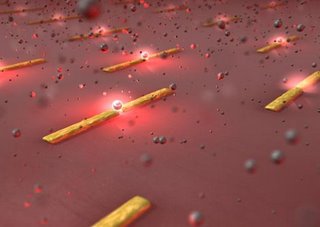Nano torch developed in Spain

Spanish scientific institute makes significant advance in nanolight technology
A nanolight developed by two researchers working for the Institute of Photonic Sciences in Barcelona (ICFO) has managed to break one of the fundamental laws of physics. The French physicist Romani Quidant and his colleague Niek van Hulst have invented a way of getting a nanolight to show bacteria that was previously impossible to see because it was too small. Furthermore their technique means that the bacteria can be seen in great detail.
The device allows scientists to work with objects 100 times smaller than before (the millionth part of a metre) because of a concentrated light 1000 times stronger than that currently in use. Their discovery is expected to open up infinite possibilities in the area of biotechnology and medicine.
The ultra concentrated light was discovered thanks to a microscopic antenna similar to the ones installed on the outside of buildings. The microscopic antenna is formed by two bars of gold that absorb the light of a laser and concentrate it onto a specific point thus forming a nanolight. Its radiation is so intense that it can interact with molecules with unprecedented efficiency.
Romani Quidant and Niek van Hulst used the resonance of plasmon which is produced with the infraction of light with metallic particles in their research. Quidant, who is currently attending a conference in Italy to present his work, explained how this new technique has avoided the ‘law of diffraction’ which until now had limited the development of optics. This law says that you can concentrate light up to a point but places a limit on the minimum size it is possible to see. He said that his research had managed to break down this limit using nanoantennas.
One of the biggest uses of his invention which is in the process of being patented is the development of optic pincers which can be used with great precision. This type of pincer concentrates light to trap objects such as cells or bacteria. The problem that scientists faced until now was that if the size of the cell or bacteria was too small they damaged an object or could not be used at all.
However this problem has been solved by Quidant and Niek van Hulst because their nanolight offers a concentrated point of light that can attach itself to polystyrene balls of 200 nanometres – 10 times smaller than with conventional pincers.
At present Quidant and Niek van Hulst Casi are working with scientists in the area of cancer research with the aim of providing a more precise diagnosis which is capable of detecting the illness in its initial stages and to look at the actual state of the cells that are ill. The invention could also be used to detect toxins in food.
Quidant who is 33 years old has spent the last three years researching this invention which is published in Nature and Physical Review Letters. After completing his thesis he began working for the ICFO.
Source: El Mundo



0 Comments:
Post a Comment
<< Home